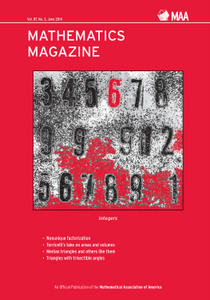- About MAA
- Membership
- MAA Publications
- Periodicals
- Blogs
- MAA Book Series
- MAA Press (an imprint of the AMS)
- MAA Notes
- MAA Reviews
- Mathematical Communication
- Information for Libraries
- Author Resources
- Advertise with MAA
- Meetings
- Competitions
- Programs
- Communities
- MAA Sections
- SIGMAA
- MAA Connect
- Students
- MAA Awards
- Awards Booklets
- Writing Awards
- Teaching Awards
- Service Awards
- Research Awards
- Lecture Awards
- Putnam Competition Individual and Team Winners
- D. E. Shaw Group AMC 8 Awards & Certificates
- Maryam Mirzakhani AMC 10 A Awards & Certificates
- Two Sigma AMC 10 B Awards & Certificates
- Jane Street AMC 12 A Awards & Certificates
- Akamai AMC 12 B Awards & Certificates
- High School Teachers
- News
You are here
Mathematics Magazine Contents—June 2014

Evangelista Torricelli was a master of areas and volumes. Writing in 1644, he recognized Archimedes's work on these subjects as an integrated whole. We saw Torricelli on these pages in October, 2013, and we will see him again before this year is out.
This issue has articles by Andrew Leahy on Toricelli, by Scott Chapman on unique (and nonunique) factorization, by Russ Gordon on triangles with trisectible angles, and much more—including Problems, Reviews, and even a crossword puzzle.—Walter Stromquist
Vol. 87, No. 3, pp. 162-239.
JOURNAL SUBSCRIBERS AND MAA MEMBERS:
To read the full articles, please log in to the member portal by clicking on 'Login' in the upper right corner. Once logged in, click on 'My Profile' in the upper right corner.
ARTICLES
A Tale of Two Monoids: A Friendly Introduction to Nonunique Factorizations
Scott C. Chapman
Arithmetic sequences are among the most basic of structures in a discrete mathematics course. We consider here two particular arithmetic sequences: 1, 5, 9, 13, 17, . . . (H) and 4, 10, 16, 22, 28, . . .(M).
In addition to their additive definitions, these sequences are also multiplicatively closed. We show that both have multiplicative structures much different than that of the regular system of the integers. In particular, both fail the celebrated Fundamental Theorem of Arithmetic. While this is relatively easy to see, we will show that while factoring elements in the set H is fairly straightforward, factoring elements in M is much more complicated. This gives us a glimpse of how systems that fail the Fundamental Theorem of Arithmetic are studied and analyzed.
To purchase the article from JSTOR: http://dx.doi.org/10.4169/math.mag.87.3.163
Evangelista Torricelli and the “Common Bond of Truth” in Greek Mathematics
Andrew Leahy
In 1664, Evangelista Torricelli published his Opera Geometrica, one of the most important—yet most unheralded—publications in the history of integral calculus. In the chapter de Dimensione arabolae, Torricelli uses the newfound analytic techniques of Bonaventura Cavalieri to prove, among other things, that all of the major geometrical works of Archimedes—Quadrature of the Parabola, On the Sphere and the Cylinder, On Spirals, and On the Equilibrium of Planes—are joined by a “common bond of truth.” In this article, we show how Torricelli establishes this connection and discuss briefly the impact it had on subsequent mathematicians such as John Wallis.
To purchase the article from JSTOR: http://dx.doi.org/10.4169/math.mag.87.3.174
Outer Median Triangles
Árpad Benyi and Branko Ćurgus
We define the notions of outer medians and outer median triangles. We show that outer median triangles enjoy similar properties to that of the median triangle.
To purchase the article from JSTOR: http://dx.doi.org/10.4169/math.mag.87.3.185
Types Theory
Brendan W. Sullivan
Supplements to this crossword puzzle are available here or here.
To purchase the article from JSTOR: http://dx.doi.org/10.4169/math.mag.87.3.196
Integer-Sided Triangles with Trisectible Angles
Russell A. Gordon
We consider the problem of finding integer-sided triangles for which all three angles in the triangle can be trisected with a compass and unmarked straightedge. Since some angles (such as 60º) cannot be trisected using only these tools, some care is required to find triangles with these properties. By the law of cosines, the cosines of the angles are rational numbers (since the sides of the triangles are integers). In order for the three angles of the triangle to be trisectible, the rational cosine values must meet certain conditions. Using some elementary aspects of the theory of constructible numbers, we obtain several general methods for finding triangles that meet our conditions, then present some examples and explore a few properties of these triangles.
To purchase the article from JSTOR: http://dx.doi.org/10.4169/math.mag.87.3.198
Surprises
Felix Lazebnik
In this article the author presents twenty-three mathematical statements that he finds surprising. Understanding most of the statements requires very modest mathematical background. The reasons why he finds them surprising are analyzed.
To purchase the article from JSTOR: http://dx.doi.org/10.4169/math.mag.87.3.212
NOTES
A Solution to the Basel Problem that Uses Euclid’s Inscribed Angle Theorem
David Brink
We present a short, rigorous solution to the Basel Problem that uses Euclid’s Inscribed Angle Theorem (Proposition 20 in Book III of the Elements) and can be seen as an elaboration of an idea of Leibniz communicated to Johann Bernoulli in 1696.
To purchase the article from JSTOR: http://dx.doi.org/10.4169/math.mag.87.3.222
Characterizing Power Functions by Hypervolumes of Revolution
Vincent Coll and Maria Qirjollari
A power function is characterized by a certain constant volume ratio associated with the surface of revolution generated by the graph of the function. We generalize this characterization to include hypersurfaces of revolution and find that power functions are similarly identified by the analogous ratio of hypervolumes of revolution. We write this ratio as an explicit function of the exponent of the power function and the dimension of the hypersurface.
To purchase the article from JSTOR: http://dx.doi.org/10.4169/math.mag.87.3.225
A Pretzel for the Mind
B. W. Corson
A variant of Laisant’s linkage-based trisector is described; its head-to-tail design has fewer parts and no slides.
To purchase from JSTOR: http://dx.doi.org/10.4169/math.mag.87.3.228
PROBLEMS
Proposals 1946-1950
Quickies 1041 & 1042
Solutions 1921-1925
To purchase the article from JSTOR: http://dx.doi.org/10.4169/math.mag.87.3.230
REVIEWS
Sharing rent; a shady underside of lotteries; beyond Ramanujan
To purchase the article from JSTOR: http://dx.doi.org/10.4169/math.mag.87.3.238




